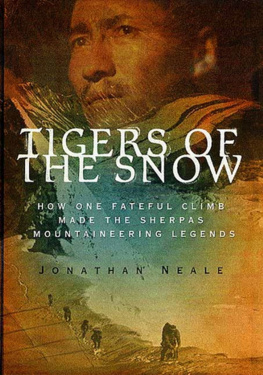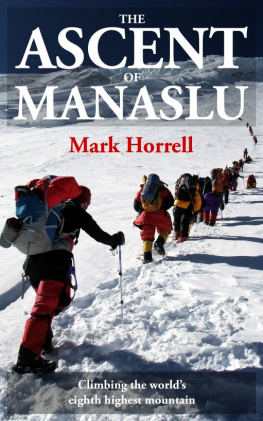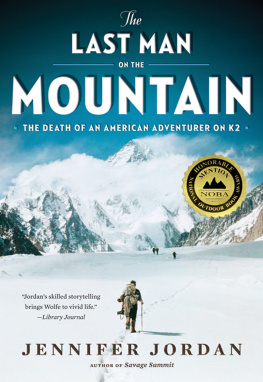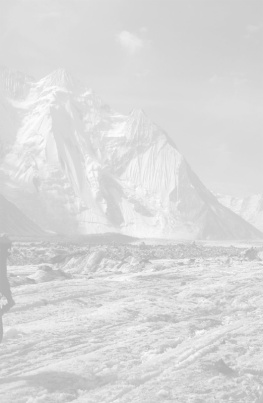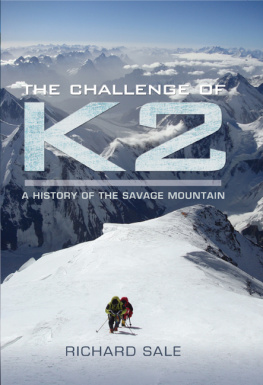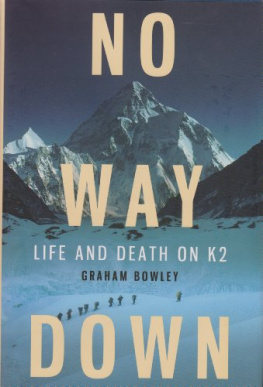ABOUT THE AUTHORS
D R . C HARLES S. H OUSTON has long been known as one of Americas foremost mountain climbers. Born in New York City in 1913, he was graduated from Harvard with an A.B. degree in 1935 and from the College of Physicians and Surgeons of Columbia University, where he received his M.D. degree in 1939. He interned in medicine at the Presbyterian Hospital in New York from 1939 to 1941. Entering the Navy as a lieutenant, junior grade, in the fall of 1941, he obtained his flight surgeons wings just prior to Pearl Harbor.
In February of 1942 he opened an altitude training unit at the Naval Air Station in Jacksonville, Florida, and later in that year opened a similar unit at the Naval Air Station in Miami. From 1942 until 1946 he was engaged in training flying personnel in the effects of high altitude, and during that period somewhere between 35,000 and 45,000 pilots passed through his units. During the last year of his naval service he was transferred to Pensacola, where he undertook a long-range study of the effects of acclimatization to high altitude, which was called Operation Everest. The account of this study was published in booklet form by the Navy.
After leaving the Navy in 1946, he spent a brief period at the Bellevue Hospital in New York and came to Exeter, where he and others opened the Exeter Clinic in April, 1947. He obtained his specialty boards in internal medicine in 1948.
Dr. Houston was introduced to mountain climbing in the Alps by his father at the age of eleven. Since that time, he has been twice to Alaska, the first time to climb Mount Crillon with Bradford Washburn in 1933, and the second to make the first ascent of Mount Foraker in 1934. He has been three times to the Alps and climbed a number of the more difficult Alpine peaks. He went to India in 1936 and was part organizer of the successful Anglo-American expedition which climbed Nanda Devi, a 25,600-foot peak and the highest summit then climbed. In 1938 he led the first American Expedition to K2, and in 1950 he went with his father on his expedition to the south side of Everest, an area they were the first Europeans to visit. Although the expedition was extremely brief, they obtained many photographs and may in a sense be said to have pointed the way for the successful climb in 1953.
Dr. Houston has a wife, Dorcas, and three children: Penny, aged 9, Robin, aged 6, and David, aged 2.
Dr. Houston was the leader of the Third American Karakoram Expedition in 1953.
Robert H. Bates was born in Philadelphia in 1911. He, too, developed an early interest in mountain climbing. His family spent their summers in New Hampshire, and by the time he was eight he had climbed all the major peaks of the White Mountains. During his freshman year in Harvard in 1929, he began to climb seriously with Bradford Washburn and other classmates. He joined Washburn on expeditions to the Fairweather Range in Alaska in 1932 and 1933. In 1935 he spent the winter with Washburn on a National Geographic Society expedition mapping 10,000 square miles in the southeast corner of the Yukon. In 1937 he and Washburn climbed what had been the highest unclimbed mountain in North America, Mount Lucania (17,150 feet). With Charles S. Houston he planned the first American expedition to K2 in 1938. The party reached 26,000 feet, an American altitude record. Out of this expedition came the book Five Miles High , which was edited by Mr. Bates.
In October, 1941, Mr. Bates became a consultant at the War Department and was commissioned shortly after the outbreak of World War II. He had charge of developing Arctic equipment in the Quartermaster Generals Office. In 1942 he was executive officer for the Alaska Test Expedition, which climbed Mount McKinley (20,300 feet) and helped develop many lightweight items used by all troops. He went to Italy as special observer for the Quartermaster General. He served at Anzio with the Third Division and ended the war a lieutenant colonel in Italy, where he received the Legion of Merit. In 1951 he was a member of the Arctic Institute of North America party that made the first ascents of two big border peaks in the Yukon (Hubbard and Alverstone). In 1953 he was a member of the Third American Karakoram Expedition to K2.
Mr. Bates has taught English at the University of Pennsylvania (1935-1939) and at Phillips Exeter Academy (from 1939 to the present). In 1947 he received his Ph.D. degree from the University of Pennsylvania.
K2THE SAVAGE MOUNTAIN
Edited by Robert H. Bates
FIVE MILES HIGH
(The Story of the First American Karakoram Expedition)
CHARLES S. HOUSTON, M.D.
ROBERT H. BATES
and Members of the Third American Karakoram Expedition:
Col. M. Ata-ullah
Robert H. Bates
George I. Bell
Robert W. Craig
Arthur K. Gilkey
Charles S. Houston, M.D.
Dee Molenaar
Peter Schoening
Capt. H. R. A. Streather
Copyright 2009 Morris Book Publishing, LLC
Introduction copyright 2000 by Jim Wickwire
ALL RIGHTS RESERVED. No part of this book may be reproduced or transmitted in any form by any means, electronic or mechanical, including photocopying and recording, or by any information storage and retrieval system, except as may be expressly permitted in writing from the publisher. Requests for permission should be addressed to The Globe Pequot Press, Attn: Rights and Permissions Department, P.O. Box 480, Guilford, CT 06437.
The Lyons Press is an imprint of The Globe Pequot Press.
Originally published in 1954 by the McGraw-Hill Book Company, Inc.
Text design by Kim Burdick
Maps by Clarence Doore
Photographs taken by Members of the Expedition
Library of Congress Cataloging-in-Publication Data is available on file.
ISBN 978-1-59921-608-9
Printed in the United States of America
10 9 8 7 6 5 4 3 2 1
To Art Gilkey
FOREWORD
F OR MANY CLIMBERS , K2even more than Everestis the ultimate mountain. At 28,250 feet, it is second only to Everest, a scant 800 feet higher. With its classic pyramidal shape, K2 is steep on all sides. It is the perfect embodiment of our mental image of what a great mountain should be like. The climber who has designs on K2s summit must not only contend with extreme altitude and difficult rock and ice, but with sudden storms that deplete strength and erode willpower. More than 160 climbers have now reached K2s summit, but for every seven persons who have accomplished this feat, one has died on the descent. In this respect, K2 is four times more deadly than Everest. All told, 49 persons have died in the process of attempting K2. Its reputation as both the most difficult and the most dangerous of the worlds fourteen 8,000-meter peaks is well deserved.
In the history of Himalayan mountaineering, the 1953 American expedition to K2 stands out as one of the most memorable. K2: The Savage Mountain , by Charles Houston, Robert Bates and other members of the third American Karakoram Expedition, chronicles their valiant attempt to make the first ascent of K2 after two other American expeditions nearly succeeded in 1938 and 1939. The account of their climb is as riveting today as it was thirty years ago.
Displaying an abundance of courage, tenacity, and strength in the face of almost overwhelming odds against their safe return, the Charles Houstonled team survived a severe ten-day storm on K2 at 25,000 feet and an accident that almost ended in disaster when virtually the entire team was involved in a fall down the mountains exposed upper slopes. Only Pete Schoenings now legendary ice axe belay saved his teammates from certain death.


